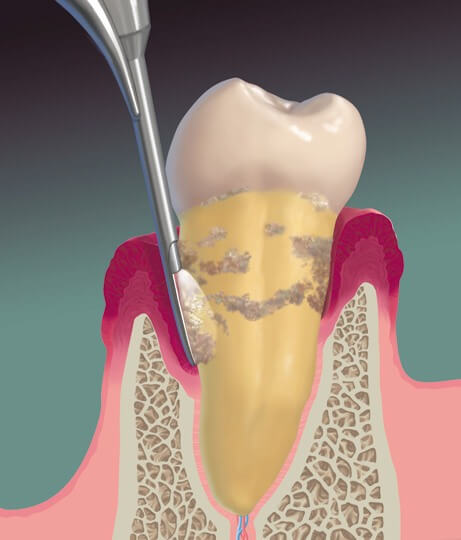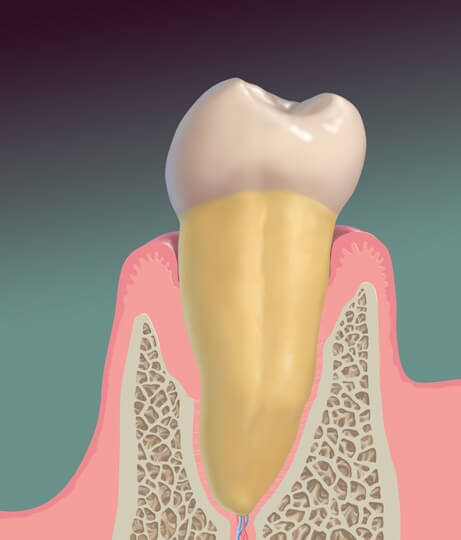Have you recently had a visit to your dentist, only to discover that you have gum disease? If so, he or she may have referred you to Dr. Kissel’s office for scaling and root planing, a non-surgical procedure to treat gum disease and stop it dead in its tracks. But, what is gum disease? What is scaling and root planing? Does it hurt? Our New York periodontist answers your questions!
If you’re experiencing gum disease symptoms, contact the best periodontist in New York City, Dr. Scott Kissel, today by calling 212-702-9088 to schedule an appointment.



Scaling and root planing is a non-surgical procedure to rid your teeth of the harmful bacteria that cause periodontitis. It’s performed in Dr. Kissel’s New York City dental office, and you will be offered anesthesia to numb your gums and teeth during the procedure.
Thought of as two different procedures: periodontal scaling is performed to rid your mouth of all bacteria and toxins, especially from your teeth and roots, and root planing is performed to smooth over your roots’ surfaces, making it harder for plaque to stick to the roots in the future.
Traditional scaling and root planing, which is the standard level of care for periodontal disease, is a blind procedure! With the traditional process, periodontists aren’t able to see the tartar on the root. This means that it’s not very effective at removing plaque, tartar, and bacteria. However, our New York City periodontist, Dr. Kissel, is one of the few periodontists who use the Perioscope to conduct scaling and root planing.
The Perioscope is a powerful dental endoscope/microscope that can display a magnified image (24-48x) on a video screen, allowing him to clearly see any tartar you may have directly on the root of the affected tooth in large detail. He can then precisely and proficiently remove the tartar more efficiently and thoroughly. Using traditional periodontal instruments, up to 30% of tooth surfaces can still have tartar – which means you’re still at risk of your case of periodontal disease progressing. This significantly limits the goal of non-surgical pocket reduction and generally leads to the recommendation for surgical treatment in the future. Traditional surgical techniques often result in significant gum tissue recession, loss of gum tissue between teeth (which is often unsightly and a food trap), and root sensitivity.
Dr. Kissel is one of the few Board-Certified periodontists in New York City with advanced training in dental implants, laser surgery, and dental microsurgery procedures. He’s also one of the only periodontists in the area to utilize the Periscope for periodontal treatment, resulting in better outcomes for patients.
Dr. Kissel is trained in microsurgery and microsurgical philosophy. Resulting in better diagnosis, planning, and treatment accuracy. Patients also experience very fast healing and little to no discomfort. This is at no additional cost to patients.
By using a Perioscope for periodontic procedures, Dr. Kissel can provide patients with the following benefits during scaling and root planing:
Scaling and root planing, also known as a deep cleaning, is a non-surgical procedure used to treat periodontal disease. It involves the removal of plaque and tartar that’s built up below the gum line and smoothes out the tooth root to prevent further bacterial growth. The scaling and root planing processes are performed together to improve oral health and prevent gum disease from progressing.
Gum disease is an oral infection caused by the bacteria that naturally occurs in our mouth. When you brush twice daily, floss your teeth daily, and have regular, biannual dental cleanings, you’re typically able to control the growth of bacteria in your mouth on your own. However, some people, either due to oral hygiene practices, habits like smoking, other medical conditions, or genetics, will develop gingivitis, the first step of gum disease. With gingivitis, your gums become inflamed, red, and swollen and can bleed easily. If caught by your dentist, regular brushing, flossing, and having biannual dental cleanings by a dental hygienist can reverse gingivitis easily.
If gingivitis isn’t treated, however, it can turn into periodontitis. With periodontitis, your gums begin to pull away from your teeth, causing pockets to form around the teeth that become infected. Your body will recognize the bacteria growing below the gum line and will attempt to fight it. However, as a side effect of this immune system response, your body will also fight the infected connective tissue and jawbone, resulting in bone loss. Only scaling and root planing performed by a qualified periodontist can stop this response and get rid of the harmful oral bacteria for good.
For those showing signs of early-stage gum disease, scaling and root planing can provide you with the following benefits:
Scaling and root planing are necessary when there’s an excessive build-up of plaque and tartar that has caused gum inflammation, bleeding, and even bone loss. A deep cleaning may be recommended if:
If you’ve had a scaling and root planing procedure performed, you must follow proper oral healthcare hygiene after your treatment to prevent periodontitis from returning. This means that you should:
No, the scaling and root planing procedure is generally painless. Your dentist will use a local anesthetic, or another form of dental sedation depending on your needs, to numb the area and minimize any discomfort.
The duration of the procedure depends on the condition of your oral health, but it usually takes one to two hours and multiple sessions. Your dentist will examine the condition of your oral health and will provide an estimated timeline. Depending on the progression of your periodontal disease, it may take more than one scaling and root planing appointment to reverse its effects.
Scaling and root planing can help to manage periodontal disease, but it’s not a cure. It’s essential to maintain good oral hygiene and keep up with regular dental visits to reduce the risk of periodontal disease recurrence.
Many dental insurance plans cover the cost of scaling and root planing, but it’s best to check with your provider to confirm your coverage. If the coverage isn’t enough, ask your dentist if their office provides special discounts or financing options.
Quick Links
Open Hours
Monday to Friday
8:30am – 5pm